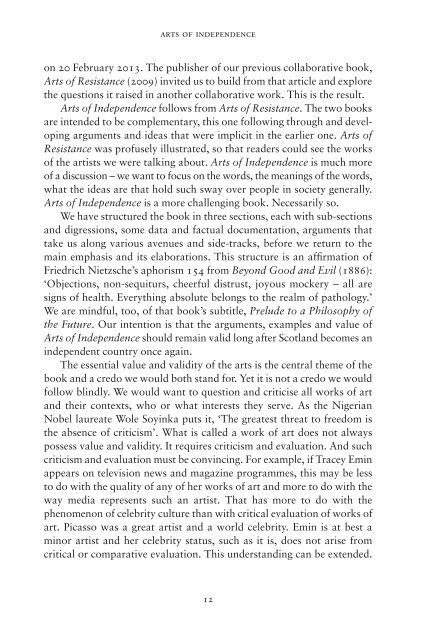Arts of Independence by Alexander Moffat and Alan Riach sampler
ALEXANDER MOFFAT and ALAN RIACH take a hard look at the most neglected aspect of the argument for Scotland’s distinctive national identity: the arts. Their proposition is that music, painting, architecture and, pre-eminently, literature, are the fuel and fire that makes imagination possible. Neglect them at your peril. For Moffat and Riach, jobs, health and trade are matters of material fact that need to be enlivened by imagination. How can we organise society to help us approach what the arts have to give. Why have we been so poor at representing our arts comprehensively, both within Scotland and internationally? What can be done? How might things be different? The arts are of paramount importance in the modern world. Moffat and Riach take the argument out of the hands of politicians and economists and beyond the petty squabbles of party politics.
ALEXANDER MOFFAT and ALAN RIACH take a hard look at the most neglected aspect of the argument for Scotland’s distinctive national identity: the arts. Their proposition is that music, painting, architecture and, pre-eminently, literature, are the fuel and fire that makes imagination possible. Neglect them at your peril. For Moffat and Riach, jobs, health and trade are matters of material fact that need to be enlivened by imagination. How can we organise society to help us approach what the arts have to give. Why have we been so poor at representing our arts comprehensively, both within Scotland and internationally? What can be done? How might things be different? The arts are of paramount importance in the modern world. Moffat and Riach take the argument out of the hands of politicians and economists and beyond the petty squabbles of party politics.
- No tags were found...
Create successful ePaper yourself
Turn your PDF publications into a flip-book with our unique Google optimized e-Paper software.
arts <strong>of</strong> independence<br />
on 20 February 2013. The publisher <strong>of</strong> our previous collaborative book,<br />
<strong>Arts</strong> <strong>of</strong> Resistance (2009) invited us to build from that article <strong>and</strong> explore<br />
the questions it raised in another collaborative work. This is the result.<br />
<strong>Arts</strong> <strong>of</strong> <strong>Independence</strong> follows from <strong>Arts</strong> <strong>of</strong> Resistance. The two books<br />
are intended to be complementary, this one following through <strong>and</strong> developing<br />
arguments <strong>and</strong> ideas that were implicit in the earlier one. <strong>Arts</strong> <strong>of</strong><br />
Resistance was pr<strong>of</strong>usely illustrated, so that readers could see the works<br />
<strong>of</strong> the artists we were talking about. <strong>Arts</strong> <strong>of</strong> <strong>Independence</strong> is much more<br />
<strong>of</strong> a discussion – we want to focus on the words, the meanings <strong>of</strong> the words,<br />
what the ideas are that hold such sway over people in society generally.<br />
<strong>Arts</strong> <strong>of</strong> <strong>Independence</strong> is a more challenging book. Necessarily so.<br />
We have structured the book in three sections, each with sub-sections<br />
<strong>and</strong> digressions, some data <strong>and</strong> factual documentation, arguments that<br />
take us along various avenues <strong>and</strong> side-tracks, before we return to the<br />
main emphasis <strong>and</strong> its elaborations. This structure is an affirmation <strong>of</strong><br />
Friedrich Nietzsche’s aphorism 154 from Beyond Good <strong>and</strong> Evil (1886):<br />
‘Objections, non-sequiturs, cheerful distrust, joyous mockery – all are<br />
signs <strong>of</strong> health. Everything absolute belongs to the realm <strong>of</strong> pathology.’<br />
We are mindful, too, <strong>of</strong> that book’s subtitle, Prelude to a Philosophy <strong>of</strong><br />
the Future. Our intention is that the arguments, examples <strong>and</strong> value <strong>of</strong><br />
<strong>Arts</strong> <strong>of</strong> <strong>Independence</strong> should remain valid long after Scotl<strong>and</strong> becomes an<br />
independent country once again.<br />
The essential value <strong>and</strong> validity <strong>of</strong> the arts is the central theme <strong>of</strong> the<br />
book <strong>and</strong> a credo we would both st<strong>and</strong> for. Yet it is not a credo we would<br />
follow blindly. We would want to question <strong>and</strong> criticise all works <strong>of</strong> art<br />
<strong>and</strong> their contexts, who or what interests they serve. As the Nigerian<br />
Nobel laureate Wole Soyinka puts it, ‘The greatest threat to freedom is<br />
the absence <strong>of</strong> criticism’. What is called a work <strong>of</strong> art does not always<br />
possess value <strong>and</strong> validity. It requires criticism <strong>and</strong> evaluation. And such<br />
criticism <strong>and</strong> evaluation must be convincing. For example, if Tracey Emin<br />
appears on television news <strong>and</strong> magazine programmes, this may be less<br />
to do with the quality <strong>of</strong> any <strong>of</strong> her works <strong>of</strong> art <strong>and</strong> more to do with the<br />
way media represents such an artist. That has more to do with the<br />
phenomenon <strong>of</strong> celebrity culture than with critical evaluation <strong>of</strong> works <strong>of</strong><br />
art. Picasso was a great artist <strong>and</strong> a world celebrity. Emin is at best a<br />
minor artist <strong>and</strong> her celebrity status, such as it is, does not arise from<br />
critical or comparative evaluation. This underst<strong>and</strong>ing can be extended.<br />
12


















